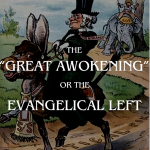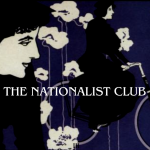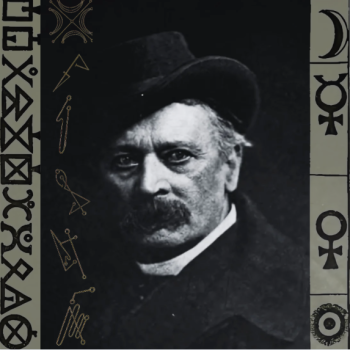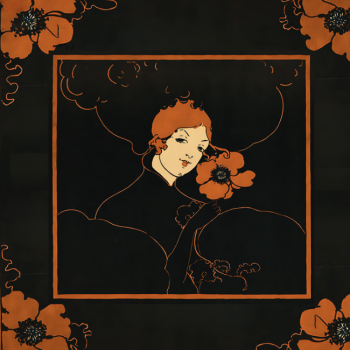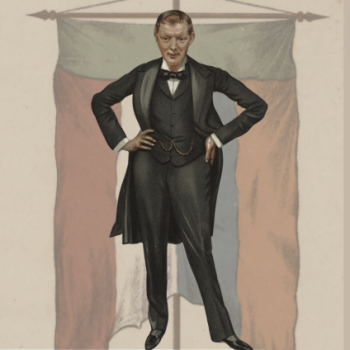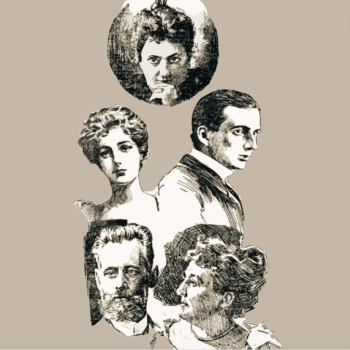Hiram Erastus Butler (1841-1916.)[1] Butler was born in Pennsylvania in 1841, was never attracted to “book learning,” and had a deep affinity for nature. In personal appearance Butler had nothing particularly striking, but there was in his manner a “peculiar fascination” which grew on acquaintance. He did not possess the gift of language, or a felicity of expression, and one always left his presence with the suspicion that that there was a great deal more to him than one could ever comprehend, or that he was ever able to express. He did have one undeniable, natural, talent for mechanics, “and the use of tools in general.” When he was eighteen, he found work as a journeyman carpenter. When the American Civil War began, Butler enlisted and served three years in the Union Army, and was instrumental in forming the first regularly organized commission to administer spiritual consolation to the wounded and dying. After the war, Butler went to Philadelphia and went to work in a furniture factory, “where he sacrificed two fingers of his right hand on a buzz saw altar.” This injury forced him to abandon this trade, and he went into the collection business.[2]
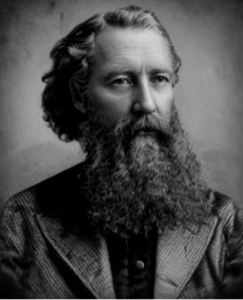
Hiram E. Butler.
He withdrew within himself “pondering over the mysteries of the world.” When his ideas took a more definite shape, and he retreated into the wilderness where he fasted in contemplative solitude. After forty days and forty nights of meditation, Butler received visions of the “unseen order ruling the chaos and sublime harmony pervading the discords of the universe.” He returned to Philadelphia where he rented a spartan room on the top floor of a business house on Chestnut Street. There he lived for three years “without acquaintances or friends or books.” In 1885 Butler joined the Rochester Branch of the Theosophical Society, having been brought in by Josephine Cables (President of the Rochester Branch.)[3] It seems that it was after joining the Society that Butler developed the principles of a system of philosophy he called “Solar Biology.” One of his theories would be the notion of a “thought-form.” Butler stated: “A perfectly celibate or chaste life enables a person to create thought forms and send them out by his will to persons near of far, so as to bring about desired results in controlling mental faculties or even physical conditions.”[4]
Trailing closely on the heels of “Esoteric Browningism” fad in Boston, it was said, was “Buddhism,” of which it was further said, “[had] not taken any very firm hold […] upon the masculinity of the Hub, but the gentler sex [had] become largely infected by it, and there [was] every prospect that it [would] soon be an all-pervading epidemic with them.”[5] This was Butler’s chance to debut his “Solar Biology.” Butler soon took to lecturing, arriving in Boston in 1886 where, that summer, he began his “Society of Esoteric Culture,” later known simply as the Society Esoteric.[6] It was essentially a counterfeit Branch of the Theosophical Society—much to the chagrin of the sanctioned Theosophists. The first President of the Society Esoteric, however, was not Butler, rather it was a man named John Latham, “a Yankee on the shady side of 50.”[7] Another member was Abraham S. Jackson, “a sort of trustee of the Society Esoteric.” A man of somewhat questionable morals, he was disbarred from the Boston bar in the 1870s and served out a sentence in prison.[8] In the summer of 1887 Butler began publishing a journal titled, The Esoteric.[9] Within these pages were printed a popular serialized essay, “Theo-Sophia” by “Nemo.”[10] This alarmed W.Q. Judge, (President of the New York Theosophical Society & Vice President of the International Society) who wrote: “This was a fraud which took in theosophists who do not get acquainted with what is written in out-of-the-way places.”[11] (The Theosophist, Julia Campbell, wrote letters to The Esoteric, hoping to reply to claims which defamed the masters. Her letters were never acknowledged.)[12]
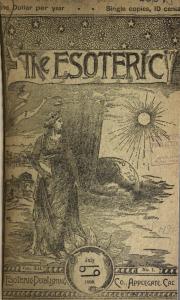
The Esoteric.
By the spring of 1888, the Esoteric Society owned a property at 478 Shawmut Avenue, a “block of slightly brownstone houses.” The first floor had been converted into a lecture room. Up one flight was a business office, which had been converted from a bed chamber. The Society Esoteric, at this point, boasted 150 members. Each paid $1 to join and contributed $.25 in monthly dues. Initially the members were primarily “aged maiden ladies and widows, and a few gray-haired men,” who listened to Butler’s lectures “with rapt attention.” There was a marked absence of young people, the newspapers noted, “but the Society Esoteric is increasing in numbers every month.”[13] That would soon change with the appearance of a young woman named Flora Manning, the daughter of an affluent merchant from North Adams. The newspapers stated: “This girl [was] a victim of Butler’s smiles, and the fascination he exerted over her […] until she [became] like him, thoroughly bad.”[14] (Around this time the press state that Butler had a wife twenty years his junior. That would make her around twenty-seven years old. It seems unlikely that Butler was married during his spiritual retreat and subsequent years writing Solar Biology. The newspapers likely assumed that Manning was his wife.)
More money came flowing in, and with the additional income, Butler was able to purchase two additional properties; a brownstone in Worcester Square “fitted up with sensuous luxury,” and an old secluded colonial mansion in Dorchester, set back from Bowdoin Street and surrounded by pines. Neighbors were mystified by what they witnessed, one of them stating: “You can see lights flashing in them windows at all hours of the night, and over in the east wing there’s a room where witches dance. I guess. There’s nights when that room is all ablaze with blue and green fire and toe smoke pours out of the windows in clouds.”[15]
W.Q. Judge began receiving letters from confused inquirers about Butler’s claims. “What is the difference between the Esoteric Society of Boston and the Theosophic Society, and is that difference very serious?” “Do the members of the T.S. practice the method of regeneration propounded by Hiram E. Butler?” “Do members of the T.S. accept ‘Solar Biology’ as a real science?”[16] This, no doubt, inspired Judge to pursue the creation of an “Esoteric Section” within the Theosophical Society, for in May 1888, he wrote to Blavatsky for advice regarding the creation of such a body.[17] Blavatsky replied: “You are directed to draw together all those persons, members of the Theosophical Society in the U.S., who have or express the desire to serve the cause of the Blessed Masters.”[18]
~
By the summer of 1888, another character entered the scene, Eli Clinton Ohmart, a “handsome, blonde young fellow,” who was born in North Manchester, Indiana, in 1861. He attended Ann Arbor (Michigan) University where he graduated ahead of his class, taking the “back door degree,” thanks to a vote of the faculty. In 1878 he married Minnie Dixon, with whom he had at least one child.[19] As early as 1880 Ohmart was a Free Though lecturer. Clarence Darrow, who attended one such lecture, said he was “a rival if not an equal of the great [Robert] Ingersoll.”[20]
In the mid-1880s Ohmart abandoned his family and moved east, where he gained some notice as the inventor of the Ohmart Arc Lamp which could safely be burned in places where combustible materials were worked (mines, dye works, stores, etc.)[21] In 1886 Robert Ingersoll introduced Ohmart to Charles Henry Washburn, a “bald-headed mesmerist adventurer of curious personal magnetism,” who moved in “good society, attend[ed] afternoon teas in Beacon Hill and [was] hand in glove with the men about town, the artists and the swell Bohemian set.” He claimed to have once been a newspaperman, as well as the chief of the United States Secret Service in New York City. He had the habit of startling his acquaintances with sensational accounts of the enterprises he was engaged in and insisted that he was in possession of secret chemical forces that would revolutionize the world.[22]
Ohmart and Washburn soon entered into business together (the contract of which was looked over by Ingersoll.) The nature of the enterprise was to conduct “experimental tests to be founded upon certain theories and laws of matter, which were joint property.” The men, backed by capital, conducted their tests in a laboratory in Melrose, Massachusetts. The partnership lasted until July 1888, when Ohmart abandoned Washburn and moved to Boston to join Butler’s Esoteric Society. He took with him a typewritten copy of the laws and the tests which formed the basis of the co-partnership, and used them as a “central factor in the esoteric college movement.”
By the autumn of 1888, Butler and Ohmart adopted “mystical names,” Adhy-Apaka and Vidya Nyaika respectively. They then developed an “inner circle” to the Esoteric Society called the Genii of Nations, Knowledge, and Religions (G.N.K.R.) with a scheme for a proposed Esoteric College in California. They announced this development in the November 1888 issue of The Esoteric with an article, “[The Call] To The Awakened,” in which they stated:
Those whose lives are a constant battle for the “truth” and whose efforts are wholly directed towards the good of the world irrespective of race and creed; those who have heard the “silence speak” and have recognized the Master’s call:—to those there will be entrusted a work more sacred and important than all they have done during their previous life, and to them there will come a Promise from One who always fulfills according to merit and eternal justice. Those who have been illuminated and who have dedicated themselves and all they “are, and hope to be,” to the guidance, those who have manifested by their lives and actions that they are under the recognition of intelligences superior to their own (not elementals or “spirits”), to those there will be given a special revelation of a character more sacred than all the secrets of the Past ; to them there will be revealed the “kingly mystery” and unto them will be given a secret more precious than the Philosopher’s Stone, more important than Aladdin’s Lamp.[23]
Butler and Ohmart were able to “[draw] on the purses of credulous people,” for the purpose of founding the Esoteric College. They told their disciples that they should give up all they had to the cause, and submit themselves to their guidance. If this was done, “then would the secrets of life be unfolded to them, and the power which the ignorant call supernatural become theirs.” A new series of circulars were issued, The Call to the Awakened, in which it was stated:
Those whose lives prove that they have dedicated their all to the Guidance, will with the permission of Adhy-Apaka be enabled to meet and talk with Vidya- Nyaika, and if the applicant proves able to receive, he will have explained that which will give him the confidence that comes of complete understanding of the methods, means, and possibilities at the disposal of the Department No. 1 , G[N.K.]R. and also of The Society Esoteric. There will be revealed to him, among other things, the proof that the ultimation of the religious work contemplated is not an impracticable dream—that the means for accomplishing such an undertaking will be placed at the disposal of the Society as soon as they are able to use the means. Such a person will know that an ideal city can in reality be built, and that it is going to be built, and that the necessary knowledge, methods and means are at hand, waiting the assistance of the proper people.[24]
In reality, young women would call at Shawmut Street to inquire about The Call To The Awakened. Flora Manning, in her capacity of mistress of Butler’s triple households, would then win the confidence of the women. The blue-eyed Ohmart would make an appearance. “Many of his devoted female followers admirers insist that he is a Mahatma,” it was said. After seducing them, he would hand the girl over to Butler and “subjected to nameless indignities at his hands, under the pretense that such treatment was necessary for her spiritual development.” At one point there was at least six young women at the Dorchester mansion who had undergone this experience. Ohmart entered into a flirtation with the elder daughter of a prominent merchant. The “unpleasant use of some letters she was so silly as to write him,” summoned unwanted attention for the group. The more damning indictment was his seduction and “illicit acquaintance” of a young woman who belonged to a highly respectable family, who moved into Butler’s home at Shawmut Avenue. Rumors of immoral practices attributed to Butler began to take definite shape with complaints made by some of the girls that were lodged with the police.
It is alleged that the influence of Butler and Ohmart has, under cover of imparting esoteric instruction in soul culture, resulting in the ruin of a score of young girls during the past year. [Butler and Ohmart] have had no lack of accommodations for the misguided girls who became Butler’s pupils, and by distributing them through these three houses, the wily professor managed to avoid publicity. Just how many girls the influence of Butler and Ohmart ruined cannot be ascertained. Their victims have naturally been more concerned in concealing their shame than in exposing their betrayers. One of these is a young lady of wealth and refinement, whose family stands high socially. She had given lavishly of her means to Butler, with a view to aiding the establishment of the “esoteric college.” Finding herself duped, disgraced, and ruined, she has had recourse to the law for redress. Two other girls who had similar experiences hare also taken measures to have the wretches punished. One young; woman, finding herself enceinte, went to a South End doctor and told shocking story of imprisonment and seduction in the Dorchester castle. Thus the story leaked out Theosophical circles here are agog with excitement over the threatened exposure of Butler.[25]
~
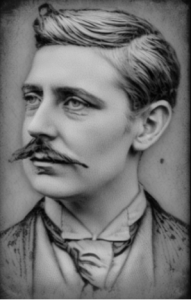
John Ransom Bridge.
From The Boston Sunday Globe. (Boston, Massachusetts) September 17, 1893.
After reading The Call To The Awakened, the Boston Theosophists pronounced Butler and the “Butlerites” as a “fraud and a swindle.” John Ransom Bridge (President of the Boston Branch, and Arthur B. Griggs (an old member of the Society,) were determined to get to the bottom of the matter. They received a letter from Blavatsky on January 1, 1889, in which she repudiated the G.N.K.R. as a “bumptious piece of charlantry and a humbug on the face of it.” Blavatsky’s decree of disapproval was sufficient enough to set the Theosophical Society against the “Shawmut Avenue people,” and they paid a visit to Butler.
Butler insisted the G.N.K.R. was based on “proper Theosophic grounds and was alright.” He further explained that they were in the “scientific business” and were there to stay. When Ransom and Griggs asked about Ohmart, Butler intimated that he was away on business “in the interest of humanity.” By chance, Charles Washburn fell in with the Theosophical investigators, and was able to explain the true identity of Ohmart. The Boston Theosophists were now on the hunt. Butler grew suspicious of their activity and their threats of exposure. In an effort to conciliate them, Butler arranged for an interview between the Theosophists and Ohmart. “And thus it happened that one Sunday [in January 1889] ‘Dr.’ Eli Ohmart walked into Mr. Bridge’s office in the Studio Building, not suspecting the lightning which was so soon to strike on all sides of him.”[26]
When Ohmart was invited to the Studio Building, Nemesis awaited him in the persons of Charles Henry and Henry W. Austin, poet and lawyer, who were after the compromising letters of the young woman before-mentioned, and the sister of the unhappy creature who is living with him.[27] Present also were United States Deputy Marshall Emery and Mr. Griggs.
The scene that ensued was very painful to the high priest of the G.N.K.R. The Nemesis did not break on him all at once, but in sections, so to speak. One by one his accusers came into the room, and at each addition his face grew yellower and more frightened looking. The wife of the businessman [Mrs. Dawson] demanded to know where her sister was, but the fellow made no answer.[28] The second time she asked he replied meekly that she had been to Professor Butler’s house, in Dorchester, and had left there this morning.
Ohmart at last weakened clean down to his boots. He owned up to having written “The Call To The Awakened,” and to his fictitious personality as Vidya-Nyaika. He insisted, however, that there was nothing mystical about the “G.N.K.R.,” and that its basis was purely on scientific grounds. He also promised to leave the Esoteric folks, and return to work with Washburn next day.
Mr. Austin now took him in tow, and before night he admitted having the letters from the young lady, and promised to return them forthwith. The letters were returned by Lawyer Abraham S. Jackson, acting on behalf Ohmart. [Jackson mysteriously died later that month.]
In spite of her efforts to rescue her sister [Mrs. Dawson] failed. Her sister left Ohmart for only one day, and then returned to the object of her mad infatuation, and at last she was still at the house of Prof. Butler.[29]
Despite his resolutions, Ohmart did not return to work with Washburn. He returned to the “esoteric brigade in the Shawmut Avenue,” and almost immediately fled the state.[30]
When a representative of The Boston Globe interviewed Butler about the turn of events, he claimed that the whole debacle was a conspiracy conducted by “Blavatsky and the Catholics.”
“What are these stories, Professor, about you and your wife being arrested for gross immorality?”
Butler took the question very coolly, and exchanged glances with Flora. “What stories?”
“That complaints have been made against you by women.”
“Have I not always advocated continence and the restraint of all evil passions?”
“Yes, but how about these rumors?”
“It’s the combined work of Blavatsky and the Catholics. Blavatsky, who is the leader of the Theosophists, has been proved to be a fraud by the English Society for Psychical Research, and she teaches the most shameful doctrines, not openly of course, because she doesn’t dare. She is jealous of me and the Esoteric College movement, and her followers have conspired against me. I’m certain these stories were started by them. Then, too, the Catholics want to crush me. Some of the priests practice magic, and they have used their arts on me. I have felt it sitting right here in this very room.”
“Yes, darling,” said Flora (nestled fondly on Butler’s arm.) “They have even said that you and I were not married.”
“Yes, dear, I know it, they have told all sorts of lies.”
“I suppose, professor, if legal action should be instituted against you, that will be amply able to defend yourself? You are no doubt quite sure of your innocence.”
“I depend upon my wife to prove that,” Butler replied.
“Yes, precious, she said. “I know you’re innocent.”
“When do you expect to start West with your colony?”
“I may go within a week if I’m not arrested. I don’t care anything for these charges, except that they will set back the work of the Esoteric college.”
“We mustn’t take any of the money for the college to fight our enemies,” said Flora
“How much has been contributed?” asked the reporter.
“We have enough on hand to start with,” was Butler’s evasive answer.
“Fifty thousand dollars?”
“It won’t need as much as that to get to work, and then we shall have all the money we need.”
“If trouble should come, you wouldn’t run away from it, would you, professor?”
Butler combed his flowing beard. “If arrests are made, I will, of course, face the music. It will not hurt me, but only retard the work of the college. Every great movement, has its enemies, but the truth will prevail in the end. You see, I am under the direction of higher intelligences, and only do their bidding.”
“Where is Ohmart?” the reporter asked.
“He’s out of town on business connected with the college.”
Butler expressed the greatest confidence in the success of his grand scheme of colonizing the soulful and trustful flock, or the “cranks who have dedicated their fraud.”[31]
Less than two weeks later (February 11, 1889) Butler fled Boston with “his deluded female neophytes fled to parts unknown,” and “also Miss Flora Manning, whose poor father is heartbroken in his home in North Adams, longing hopelessly for his daughter’s return.” The papers did not spare Manning. “To her door is laid the charge of active participation in the conspiracy that led to the ruin of no less than seven of Boston’s daughters whose credulity led them to place themselves in Butler’s power in the vague hope of becoming mediums.”[32] Blavatsky had her say on the matter with a letter published in the March 8, 1889, issue of The Boston Globe.[33]
The G.N.K.R., nevertheless, seems to have troubled Blavatsky. In her letter to the American Section for their Third Annual Convention (April 1889) she wrote: “As many of you are aware, we have formed the ‘Esoteric Section.’ […] Its name, however, I would willingly change. The Boston scandals have entirely discredited the name ‘Esoteric’; but this is a matter for after consideration.”[34]
Butler and his followers would establish a colony in California within three years, known as “Applegate.” The 300-acre tract of the compound was donated for the purposes of the G.N.K.R. by a “Mrs. White of Boston.”[35]
SOURCES:
[1] Ancestry.com. U.S., Veterans Administration Master Index, 1917-1940 [database on-line]. Lehi, UT. USA: Ancestry.com Operations, Inc., 2019. Original data: United States, Veterans Administration Master Index, 1917-1940. Salt Lake City, Utah: FamilySearch, 2019. Veterans Administration Master Index, 1917 – 9/16/1940. NAI 76193916. Record Group 15: Records of the Department of Veterans Affairs, 1773 – 2007. National Archives at St. Louis, St. Louis, Missouri, U.S.A.
[2] “Occult Lore.” The Boston Globe. (Boston, Massachusetts) June 17, 1888.
[3] Theosophical Society General Membership Register, 1875-1942 at http://tsmembers.org/. See book 1, entry 3367. (website file: 1B:1885-1890); Hiram E. Butler. [6/8/1885] Rochester T.S. [Lived at 1342 Arch Street Philadelphia]
[4] “Occult Lore.” The Boston Globe. (Boston, Massachusetts) June 17, 1888.
[5] “‘Buddhism’ Boston’s New ‘Fad.’” The Buffalo Commercial. (Buffalo, New York) February 16, 1887.
[6] “The Society of Esoteric Culture.” The Boston Evening Transcript. (Boston, Massachusetts.) December 21, 1886.
[7] “Occult Lore.” The Boston Globe. (Boston, Massachusetts) June 17, 1888.
[8] “Eli And His G.N.K.R.” The Evening World. (New York, New York) February 1, 1889.
[9] Butler, Hiram E. “A New Cycle Of Progress.” The Esoteric. Vol. I, No. 1 (June 21-July 22, 1887): 1-5.
[10] Nemo. “Theo-Sophia: Letter to a Seeker: Pt. I.” The Esoteric. Vol. I, No. 10 (March 21-April 19, 1888): 369-373; Nemo. “Theo-Sophia: Letter to a Seeker: Pt. II.” The Esoteric. Vol. I, No. 11 (April 19-May 20, 1888): 390-392.
[11] Judge, William Quan. “Occultism For Barter.” The Path. Vol. III, No. 12 (March 1889): 381-363.
[12] Ver Planck, J. Campbell. “Theo-Sophia.” The Path. Vol. III, No. 10 (January 1889): 320-325.
[13] “Occult Lore.” The Boston Globe. (Boston, Massachusetts) June 17, 1888.
[14] “Butler’s Theosophists Flee.” The Lancaster Intelligencer. (Lancaster, Pennsylvania) February 13, 1889.
[15] “Our Boston Letter.” The United Opinion. (Bradford, Vermont) February 8, 1889.
[16] “Answers to Questions.” The Path. Vol. III., No. 4. (July 1888): 123-125.
[17] “Dear H.P.B.—Please reply to this. So many people are beginning to ask me to be Chelas that I must do something, so I have drawn up the enclosed paper which you can send me with some formalities on it as you think right to do so––or whatever I ought to have. If you do not think so, then please tell me in what way I had best proceed. I know a good many good ones who will do well and who will form a rock on which the enemy will founder, and this plan would encourage them. So fiat something.” [Blavatsky, H.P; De Zirkoff, Boris (ed.) H.P. Blavatsky Collected Writings: Vol. XII (1889-1890.) The Theosophical Publishing House. Wheaton, Illinois. (1980): 478-480; [W.Q. to H.P. Blavatsky. May 18, 1888.] Judge, William Quan, and A. L. Conger. Practical Occultism. Theosophical University Press. Pasadena, California. (1951.)]
[18] “You are directed to draw together all those persons, members of the Theosophical Society in the U.S., who have or express the desire to serve the cause of the Blessed Masters. This you are to do with the understanding in writing in every case that the persons taken are not thereby made Chelas of the Masters, but simply that they are thus given a chance to make a preliminary trial of themselves, and in each case, you will take from the applicant an expression in writing, before making your private register of the names, that they well understand the basis on which you thus take them. Nothing is promised; each will have just what he or she deserves––no more, no less. And all must be faithful to the Cause, to Masters, and to the founders of the Theosophical Society.”[Blavatsky, H.P; De Zirkoff, Boris (ed.) H.P. Blavatsky Collected Writings: Vol. XII (1889-1890.) The Theosophical Publishing House. Wheaton, Illinois. (1980): 478-480; [W.Q. to H.P. Blavatsky. May 18, 1888.] Judge, William Quan, and A. L. Conger. Practical Occultism. Theosophical University Press. Pasadena, California. (1951.)]
[19] Ancestry.com. Indiana, U.S., Marriages, 1810-2001 [database on-line]. Provo, UT, USA: Ancestry.com Operations, Inc., 2014. Original data: Indiana, Marriages, 1810-2001. Salt Lake City, Utah: FamilySearch, 2013.
[20] Kersten, Andre E. Clarence Darrow: American Iconoclast. MacMillan. New York, New York. (2011): Chapter 2.
[21] “The Ohmart Arc Lamp.” The Telegraphic Journal And Electric Review. Vol. XIX, No. 461 (September 24, 1886): 297-298.
[22] “Our Boston Letter.” The Landmark. (White River Junction, Vermont) February 8, 1889.
[23] Butler, Hiram E. “To The ‘Awakened.’” The Esoteric. Vol. II, No. 5 (October 22-November 21, 1888): 208-214.
[24] Butler, Hiram Erastus. The Call To The Awakened. The Esoteric Publishing Company. Boston, Massachusetts. (1888): 7-25.
[25] “Our Boston Letter.” The United Opinion. (Bradford, Vermont) February 8, 1889.
[26] “Eli And His G.N.K.R.” The Evening World. (New York, New York) February 1, 1889.
[27] Henry W. Austin would later be named Treasurer of the Theosophical Society and Universal Brotherhood, incorporated in October 1889. [“Theosophs Incorporated.” The Boston Globe. (Boston, Massachusetts) October 26, 1889.]
[28] “Mrs. Dawson has been trying to rescue her sister from Butler’s Dorchester stronghold, but the girl has disappeared.” [“Our Boston Letter.” The United Opinion. (Bradford, Vermont) February 8, 1889.]
[29] “Eli And His G.N.K.R.” The Evening World. (New York, New York) February 1, 1889.
[30] “Eli And His G.N.K.R.” The Evening World. (New York, New York) February 1, 1889.
[31] “G.N.K.R.” The Boston Globe. (Boston, Massachusetts) February 2, 1889.
[32] “Butler’s Theosophists Flee.” The Lancaster Intelligencer. (Lancaster, Pennsylvania) February 13, 1889.
17 Lansdown Road, Holland Park.
London, February 19, 1889.
To the Editor of The Boston Globe:
In your issue of Feb. 2. in the report of the interview between your representative and “Professor” Butler, as well as in several other papers of New York and Boston, I was called by that too speculative gentleman a “fraud.” Moreover, it was stated by this same “Professor,” in answer to the reporter’s question, whether “all the Theosophs were favorable to his movement.” “No, they hate us for our many virtues.” And he added to this piece of sublime effrontery a calumny, viz., that all the Theosophs and “Mme. Blavatsky herself cling to the pernicious doctrine that the way to conquer the passions is to exhaust them through gratification.”
A more foul or a blacker lie could never be uttered. Since 1875, almost before the Theosophical Society was first formed, I had unrelentingly exposed the criminality of this vile doctrine. The secret origin of my countless enemies lies there. I had denounced P. B. Randolph and his doings and teachings in certain eso-terico-maguetic centres for the practical carrying out of his doctrines, which he had established in Boston, calling them Rosicrucian mysteries. I denounced the “Pentarchy” of shameful memory in New York, established by Stephen Pearl Andrews, and the still more infamous psychic clubs connected with Mrs. Victoria Woodhull. Fearlessly pointing out the trail of the serpent wherever I found it, I roused the enmity of the thousands of their followers who were all Spiritualists. And now the man pointed out as a great hierophant of the revived priapic orgies of Lampsacus in Shawmut Avenue, turns the tables upon those who had never heard of his name till three months ago. The famous Adhy-Apaka and Vidva-Nyaika are called in the most unwarrantable way by the newspapers “theosophic knaves,” “theosophic swindlers,” etc., though neither had ever belonged to our Theosophical Society. Why a mass of honest people should be so flippantly, identified with a gang bent on obtaining money from people under false pretenses—for their pretenses are false, as I will prove—shows the utter disregard in this age of ours for truth or justice. But this is the concern of American Theosophists, and if they do not choose to stand by their flag and prevent it from being covered with mud, so much the worse for them.
I am said, in many papers, to have repudiated and exposed Vidya Nyaika, alias Eli Ohmart. I confess to the repudiation and I indorse the exposé, though not done by myself. The Theosophists who brought it about have only done their duty. Another preposterous boast of the too “occult professor” is that I am jealous of him. I never heard his name till the last days of December; I did not even know he was the editor of the Esoteric, which being at first a very decent magazine, I noticed favorably in Lucifer, though even then I was forced to point out that the major part of its contents was drawn without acknowledgment from theosophical publications. His name was first mentioned to me by an American gentleman who told me that he was only two years ago, a medium telling fortunes at $1 per sitting. This was just after I had received that most marvelous mystification of the ages, the “Call to the awakened from the interior of the inmost,” and my friends asked me what it all meant.
In your issue of Feb. 6 one C.H. Mackay, an “ardent disciple” of Butler’s, speaks of “the well-known Blavatsky” and traces the present exposé of Butler & Co. to the jealousy felt by her of their selection by the G. N. K. R. Permit the “well-known Blavatsky” to answer that she condemns no person or persons, but ugly things and actions she must and always will condemn. As to Vidya-Nyaika-Ohmart and Adhy-Apaka-Butler, they may be told in the words of Job: “Thine own mouth condemneth thee and not I; yea, thine own lips testify against thee.” For a single glance at the 200 pages of the “Call from the Unseen and Unknown for an Esoteric College” and their “Special message from the interior of the inmost to the awakened,” is sufficient to form an unwavering opinion. This bumptious pamphlet can only be the production of a lunatic or a charlatan: moreover, it is the work of one entirely ignorant of Eastern philosophy and speculating on the existence of the same ignorance among those he appeals to. Such phrases as “the priori and Sambudhistic Philosophy of Kupila,” “the laws of Ens, Movens and Aum” (!?) on page 32, are more than enough to turn the most gullible stomach, as they have no meaning in any Eastern school of philosophy and are a mere jumble of contradictory terms. Again on page 172 we find a presumably Hindu sage, “bent under the weight of centuries,” appealing to the guidance of the Jewish Kabalistic Yahveh, the Christian Messianic cycle, the Brahminical Aum, and ending by the Tibetan “Om mani pad me hum;” the last word of which formula he misspells Aum, thus showing the most complete ignorance of the most elementary facts of Eastern philosophy. Moreover, the entire pamphlet is bodily stolen and travestied from well-known theosophical text books.
So, for instance, on page 25, I find, “’The human heart has never fully uttered itself,’ says Festus.” This is given as a quotation from the author of “Festus” himself, but in reality, the words are mine, and convey only the idea of “Festus,” the passage being taken from Isis Unveiled, Vol. I, page 1, of the preface. Again on page 186 of the “Call,” the well-known motto of the Theosophical Society, “There is no religion higher than truth,” is filched without a word of acknowledgment. On every page I can trace ideas stolen from our theosophical writings, mainly from The Theosophist and Isis Unveiled and often whole sentences. There is not an original idea or thought in the whole pamphlet from first page to last. Some of these may seem trifling details, but they are mighty landmarks to those who are robbed of their ideas and writings, and see their highest ideals desecrated and made the prey of venal speculators.
Therefore do not hesitate to proclaim the writers of this “Call” crows in peacock’s feathers, thieving magpies repeating the words of others and turning them to a most criminal use by playing on people’s feelings to get money, so that the “awakened” will indeed awaken to find their pockets have been entirely emptied.
Occult knowledge is not to be sold. As said in my editorial in the January Lucifer: “He who has anything to teach, unless like Peter to Simon he says to him who offers him money for his knowledge, ‘Thy money perish with thee, because thou hast thought that the gift of (our inner) God may be purchased with money,’ is either a black magician or an impostor.” As the “Esoterics” make no secret of having obtained in one month more than S40,000, and as they moreover invite people to give all they have (not a portion of their superfluity,) I leave the reader to draw his own conclusions.
And now for the reason why I feel in duty bound to expose the false Vidya Nyaika and Adhy Apaka. Had they claimed as their teachers some adept from the planetary spheres, or boasted of the power of obeeyahs or voodoos, or even after the manner of P. B. Randolph, by direct communication with Rosicrucia (whoever this young lady may be,) I would have laughed and held my tongue in silent pity for those caught by their baits. I am not a detective bent on discovering frauds. That I leave to the honorable agents of the Psychical Research Society. But once they have done their utmost to throw discredit and suspicion on those whom the Theosophical Society calls masters, by putting over their heads a mythical Vidya Nyaika, I cry “Halt.”
I proclaim the sage, “bent under the weight of centuries,” an impossible animal in nature, and one supposed to have his seat astride on the top of the Himalayas only to visit Hiram Butler’s temple of mysteries, no “Mahatma of Hindu adept on a mission in the interest of humanity,” but a mere lay figure used to gain money and property under false pretenses.
The Butlerites have already flung into my teeth the accusation put forward by the Psychic Research Society. But this accusation was never proven, while it was absolutely proven and admitted by the society in their report that I had never taken a penny from anyone, rejected all offers of money, and given all I had or earned by my literary work to the cause of Theosophy. This has little resemblance to Mr. Butler’s doings. The whole thing, indeed, lies in a nutshell.
Among other things, I am accused of having “invented” the Mahatmas. Let it be so. There are then but two alternatives: (1) Either I have invented them and forged their numerous letters; or (2) I speak the truth. If I have invented the Mahatmas, I have certainly not invented Vidya Nyaika and Adhy Apaka, who would thus be entitled to rank as my humble but rather clumsy imitators, were it not that an adept such described in the “Call to the Awakened” is a creature that can exist only in the delirious nightmare of a drunkard on a lunatic. And if I speak the truth, i.e., if I am really acquainted with and the devoted servant of a real living adepts in the occult sciences, then I ought to know whether there is such a being as Vidya Nyaika. I can say that this ideal is a grotesque caricature.
Real adepts are men as all others, except in the wonderful knowledge acquired by them throughout a series of incarnations and in the holiness of their lives. They cannot live long centuries in one body. Though, since there are cases in the medical records of longevity reaching 175 years, there is nothing impossible in a man, knowing the occult secrets of certain plants and alchemy, making his body last even far beyond that period. But this, however, very few of them do. Our masters do not sit astride on the Himalayas or approve of chelas ruining young girls. Their morality is of the highest order and knows no compromise.
Knowing all this, I have no hesitation in closing this letter by saying that the grand secret society of G. N. K. R. does not mean as claimed, the “Society of the Grail of Nations, Knowledge and Religions”; but that verily, for every sane man not blinded with prejudice, these initials should stand for—Galls Nabbed by Knaves and Rascals.
Yours very obediently,
H.P. Blavatsky.
[“Blavatsky On Butler.” The Boston Globe. (Boston, Massachusetts) March 8, 1889.]
[34] “Madame Blavatsky’s Letter.” Report Of The Theosophical Society, American Section: Third Annual Convention.
[35] “Recluse Of The Mountains.” The San Francisco Examiner. (San Francisco, California) July 9, 1892.


